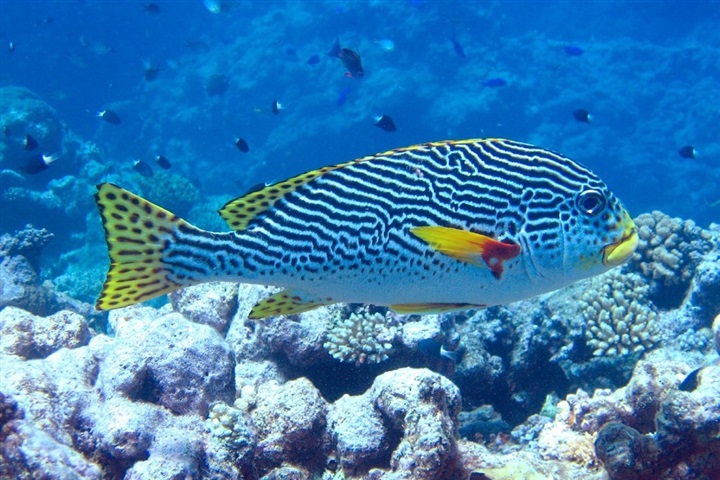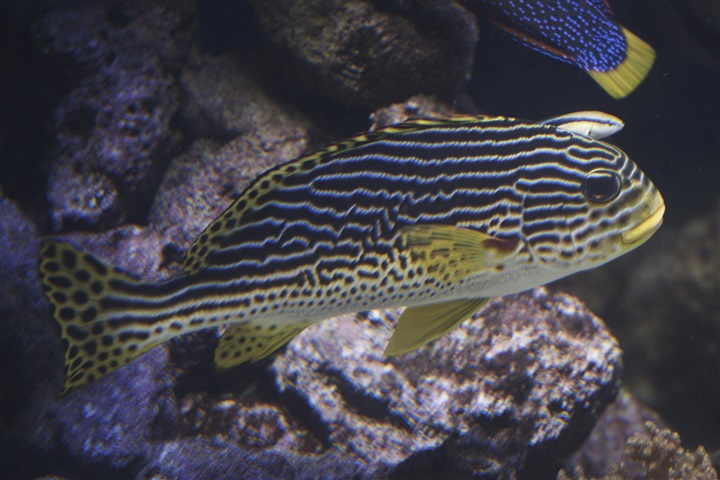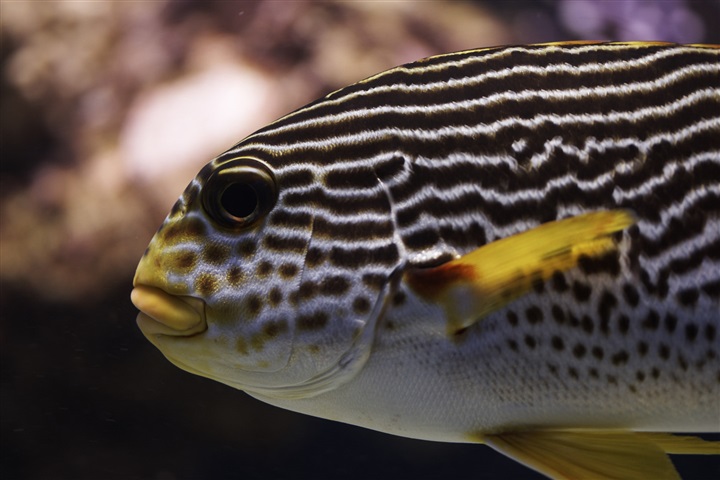Plectorhinchus lineatus
| Latin name | Plectorhinchus lineatus - (Linnaeus, 1758) |
|---|---|
| Local name | Yellowbanded sweetlips |
| Family | Haemulidae - Plectorhinchus |
| Origin | East Indian Ocean, West Indian Ocean, Australia, Japan, The Red Sea, Indonesia, East Pacific, New Zealand, Central/West Pacific |
| Max length | 72 cm (28.3") |
| Minimum volume |
2000 l (528 gal) |
|---|---|
| Hardiness |
Average |
| Suitable for aquarium |
Suitable with care |
| Reef safe |
Reef safe with caution |
| Aggressiveness | Docile |
| Recommended |
Fish Larger crustaceans (Shrimp, crabs...) Other invertebrates Small crustaceans (Krill, mysis, artemia...) |
|---|
This species grows very quickly if fed well.
This species can be a threat towards small fish, shrimps, small bivalves, worms, snails and the like.
This species searches through the sand for food, which can make the water cloudy and shakes up detritus.
In an aquarium their natural food source in the sand is quickly exhausted.
This species needs a very large aquarium when fully grown.
Exactly how big the aquarium should be is hard to say, but the size of this species is such, that it cannot normally be kept in a home aquarium.
This species must be fed with an appropriately varied diet.
This species eats a great deal and demands an aquarium that can tolerate such a heavy load.
There is a greater chance of success with this species if one can supply a living feed to allow it to adapt to the tank.
This fish requires feeding several times a day, especially when newly added.
When the fish can find its natural food in the aquarium it requires less frequent feeding.
This species needs good hiding places, for example, between live rocks.
This species revels in swimming and requires an aquarium with ample space.
This species is very shy and docile, so one should be careful when keeping it with more aggressive fish.
Fish within in the Grunt family do not often appear in private aquaria, but can be kept in a very large tank under proper conditions. They are predatory fish and mostly live off benthic crustaceans, worms and fish.
There can be a big difference in appearance when the fish is young and fully grown.
This family can divided into two groups: Plectorhinchinae (Sweetlips) and Haemulinae (Grunts).
Aquarists normally find Sweetlips to be the best looking, but they can be difficult to feed and it can be problematic giving them food containing enough nutrition. Grunts are more hardy and quicker to start feeding in aquaria.
It can be a good idea to have live food, Mysis or small live freshwater shrimp, in case these fish don't begin to feed.
One should not acquire these fish with the intention of selling them on when they get bigger. This is, not only because they grow quickly if fed correctly, but also because they are difficult to sell on to domestic buyers.
Sweetlips include the genera of Diagramma and Plectorhinchus.
Grunts include the genera of Anisotremus and Haemulon.
| Aquarium trade | Yes |
|---|---|
| Distribution | Western Pacific: from Ryukyu Islands to Ogasawara Islands to the Great Barrier Reef and New Caledonia. |
| English common names |
Silver-banded sweetlips Yellowbanded sweetlips Yellowband sweetlip Diagonal-banded sweetlips Goldman's sweetlips Oblique-banded sweetlips |
| French common names |
Diagramme à bandes diagonales Gaterin à bandes diagonales |
| Danish common names |
Gulbåndet gryntefisk Goldmans gryntefisk |
Bob Fenner. The Grunts Called Sweetlips, Family Haemulidae, Subfamily Plectorhynchinae - Wet Web Media - (English)
Scott W. Michael. 2004. Angelfishes and Butterflyfishes (Reef Fishes Series Book 3) TFH Publications / Microcosm Ltd. - (English)
Bob Fenner. Indonesian Grunts & Sweetlips, Family Haemulidae - Wet Web Media - (English)
WWM Crew. FAQs on Grunts, Sweetlips, Family Haemulidae - Wet Web Media - (English)




